Mental Health at Work

While mental health concerns are not partial to any one demographic, conversations around the topic tend to focus on the plight of teens and millennials – often relating a decline in mental health to the stressors of high school and college. Although we do see a rise in mental health issues during these periods, life beyond graduation plays host to an entirely new set of environmental stressors.
One in 5 American adults have a mental health condition, and serious psychological distress is on the rise. But what is contributing to this rise? Similarly to high school and college, the modern workplace can intensify stress and even contribute to a decline in mental health. We surveyed 1,012 full-time American employees to analyze their mental health at work and understand what could potentially ease this issue.
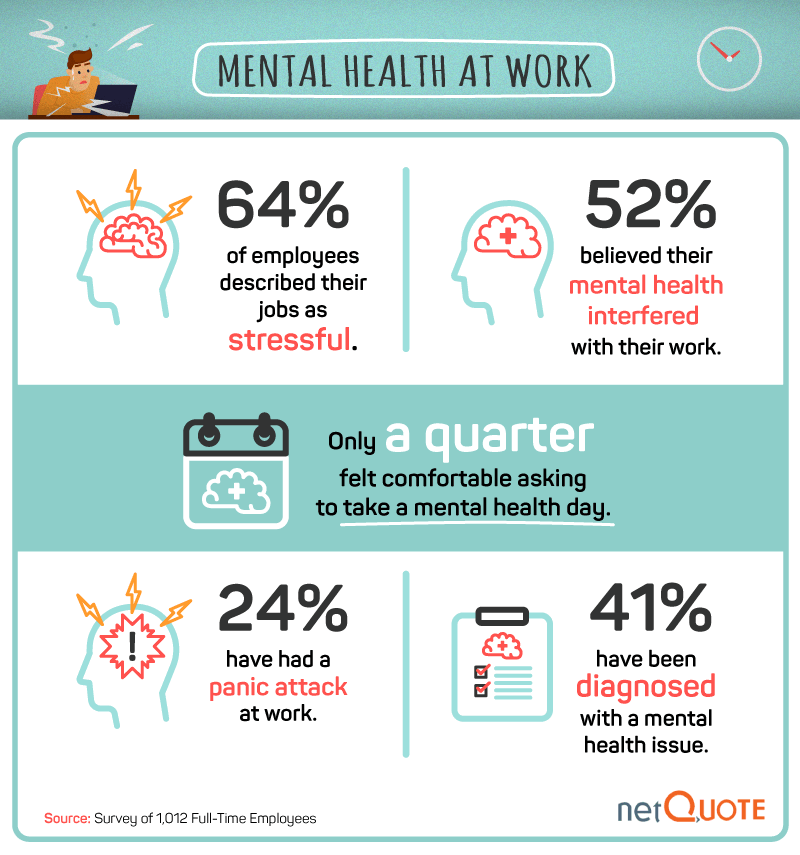
Regardless of the field, jobs can be demanding and take up a majority of our time, so it shouldn’t come as a surprise that a majority of full-time American employees described their jobs as stressful. However, while stress can certainly play a role in people’s mental health status, it may not necessarily lead to a diagnosis. Forty-one percent of full-time employees were diagnosed with a mental health issue, and 52 percent felt their mental health interfered with their work.
Additionally, only a quarter felt comfortable requesting a day off for mental health. Full-time private industry jobs often come with an average of seven to nine days of paid sick leave, depending on seniority, but even when physically ill, many employees still show up to work. According to the NSF International, Americans feel they are expected to show up regardless of their health. They also report being fired or threatened for taking time off when sick. Mix the stigma attached to mental health and the pressures people already feel to show up to work, and asking for a mental health day seems almost impossible.
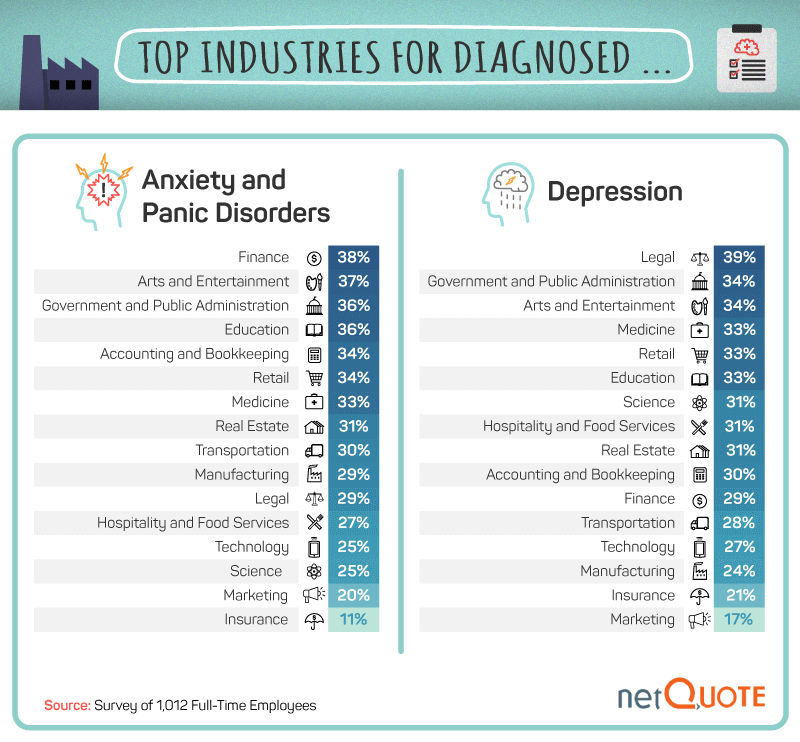
Approximately 40 million Americans have been diagnosed with an anxiety disorder. Depression affects 6.7 percent of the U.S. population in a given year but remains the leading cause of disability for those aged 15 to 44. Disorders falling under these categories have high comorbidity, meaning those with an anxiety disorder also often suffer from depression and vice versa.
The industries whose employees suffer from each differ, though. Finance was the leading industry when it came to anxiety and panic disorders, with 38 percent of full-time employees receiving a diagnosis at some point. The legal field saw the highest rate of depression, with 39 percent of employees diagnosed. Arts and entertainment along with government and public administration, however, ranked high for both anxiety and panic disorders and depression. On the other side, marketing and insurance had the lowest rates of diagnosed anxiety and depression.
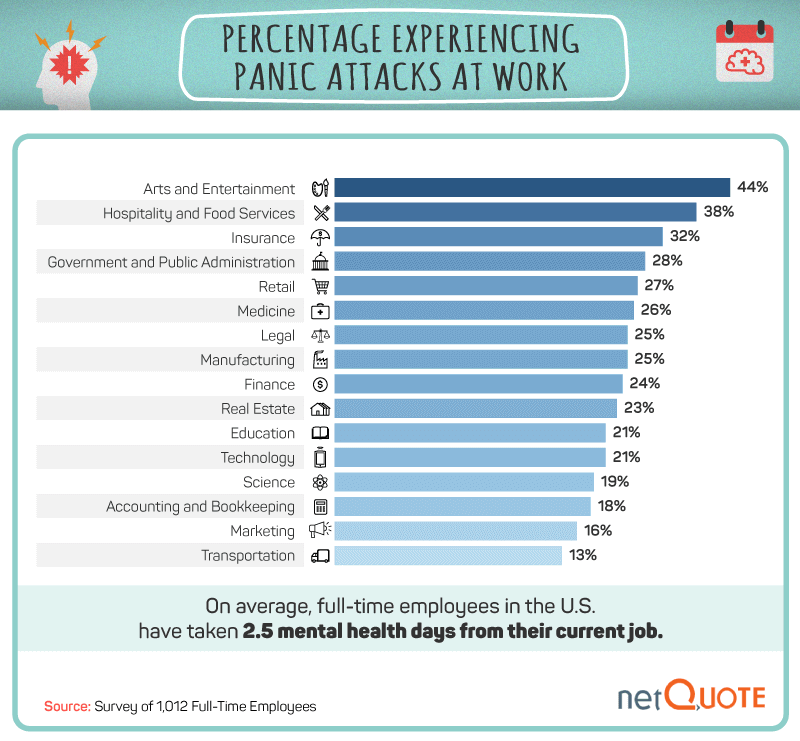
Those with psychological disorders, specifically ones falling under or related to anxiety, often experience panic attacks. However, many people who are not diagnosed or don’t meet the criteria for diagnosis also experience panic attacks. Panic attacks can occur in any situation, despite the presence of an actual threat. Employees in arts and entertainment experienced the highest rate of panic attacks at work, followed by hospitality and food services. While panic attacks can occur without warning, these fast-paced environments may add to the likelihood of a panic attack taking place on the clock.
Taking mental health days doesn’t happen very often, but respondents did report taking almost three days from their current jobs in order to reestablish mental health. Though they may have been registered as standard sick days or vacations, full-time employees were admitting to taking some time to regather their mental stability. Since more than half of respondents told us that their mental health had interfered with their workload before, these days off were most likely beneficial to both employees and employers alike.
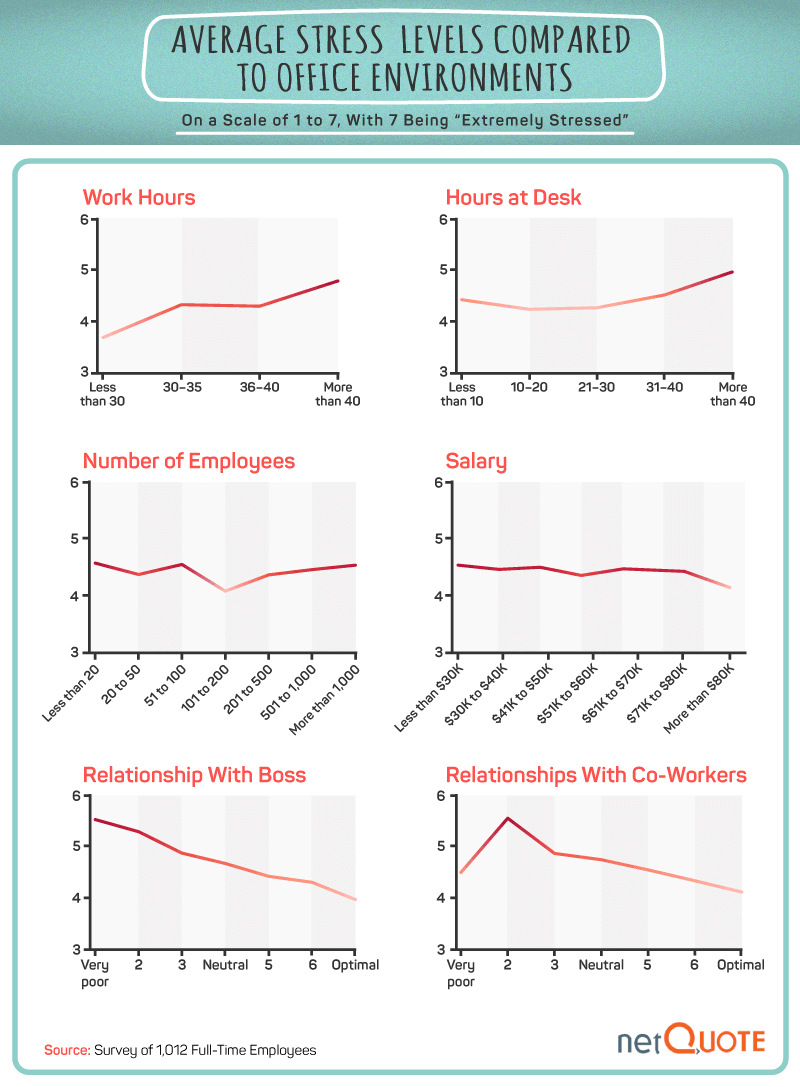
Specific job factors may not directly cause a panic attack, but they can certainly increase stress levels. Employees reported a significant rise in stress as work hours increased. On a scale of 1 to 7, with 7 being extremely stressed, employees working more than 40 hours a week rated their stress level near a 5 on average. Stress levels in relation to hours spent at a desk showed a similar increase when exceeding 40 hours.
Average stress levels stayed pretty steady across all salaries, though it may be counterintuitive to think that additional income doesn’t relieve stress. Good relationships actually may be the link to happiness at work, though. The more optimal the relationship between employee and boss or co-worker, the less stress one felt. Poor relationships were the only factor where stress levels neared a 6 on our scale.
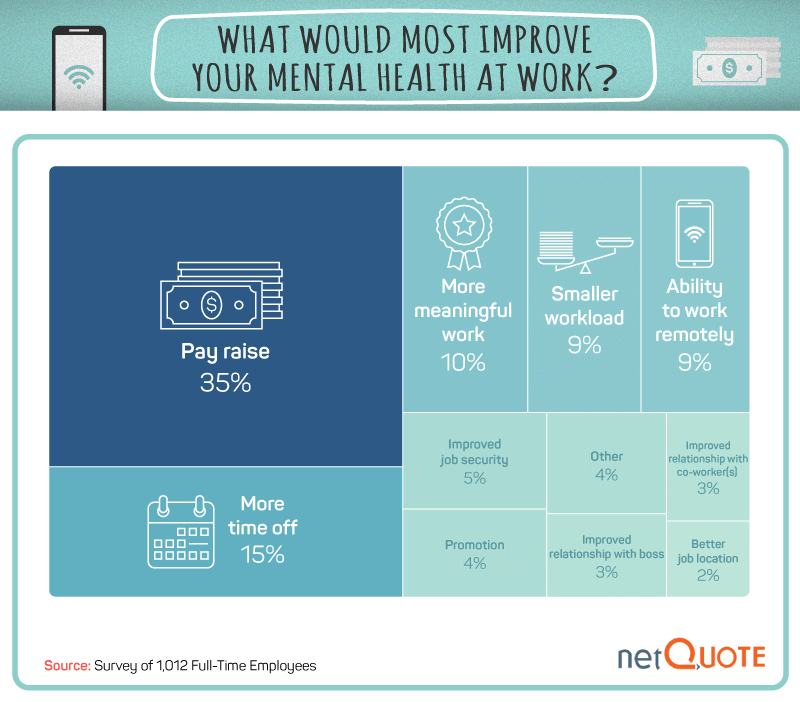
It’s clear relationships had the greatest effect on stress levels while income didn’t make that much of a difference, but when asked what would improve their mental health, employees felt a pay raise would help the most, while an improved relationship was viewed as much less impactful. A pay raise may make resources more accessible and, therefore, help improve people’s mental health. There are ways to get mental health coverage, but the problem may be finding a therapist or mental health resource that accepts certain insurance. Therapists are the least likely to accept insurance, so seeking help for mental health issues has become extremely expensive and a luxury few can afford.
We’re Here to Help
The only way to truly improve mental health rates in America is to talk about it. The stigma attached to mental health may not only make sufferers feel alone and helpless – its effects can be seen in the industries controlling mental health services as well. Insurance companies don’t treat mental health the same way they treat physical health, at times leaving people to just “deal with it.”
Allowing for an open dialogue about mental health may be the only way to throw the stigma out the window and get the help employees need. As the conversation slowly develops, the best way to receive help right now is to pick your insurance plan carefully. Visit us at netQuote.com to browse and compare free insurance quotes to make sure you and your family’s needs are covered. It’s OK to ask for help, and we’re here to assist you in finding the best plan.
Methodology
We surveyed 1,012 people who worked full-time positions in the U.S. Of this group, 49 percent were men, 51 percent were women, and less than 1 percent identified as a gender not listed in our study. Participants ranged in age from 18 to 75, with an average of 36 and a standard deviation of 9.7. To determine the effects of full-time jobs on mental health, we compared diagnosed mental health conditions against various industry factors. Stress levels, however, were determined by asking participants to rate their own feelings of stress on a scale of 1 to 7, with 7 being “extremely stressed.” No statistical testing was performed, and as such, this data is purely exploratory.
Sources
- https://www.huffingtonpost.com/entry/youth-mental-health-report_us_5a0d02c4e4b0b17e5e13f4f4
- http://time.com/4473575/college-mental-health-guidebook/
- http://www.mentalhealthamerica.net/issues/state-mental-health-america
- http://www.health.com/depression/8-million-americans-psychological-distress
- https://www.bls.gov/opub/ted/2016/number-of-paid-sick-leave-days-in-2015-varies-by-length-of-service-and-establishment-size.htm
- http://www.nsf.org/newsroom/survey-finds-being-sick-doesnt-keep-hard-working-americans-out-of-the-workp
- http://www.bbc.com/news/world-us-canada-37353742
- http://www.apa.org/helpcenter/data-behavioral-health.aspx
- https://www.nami.org/Blogs/NAMI-Blog/January-2018/The-Comorbidity-of-Anxiety-and-Depression
- https://adaa.org/understanding-anxiety/panic-disorder-agoraphobia/symptoms#
- https://www.huffingtonpost.com/entry/therapy-expensive-insurance_us_5900048ee4b0af6d718992e7
Fair Use Statement
Do you know somebody who works full time and may be dealing with a mental health issue? Feel free to share this study and use the images and content for noncommercial purposes. Just don’t forget to link back to this page to give the authors proper credit.
